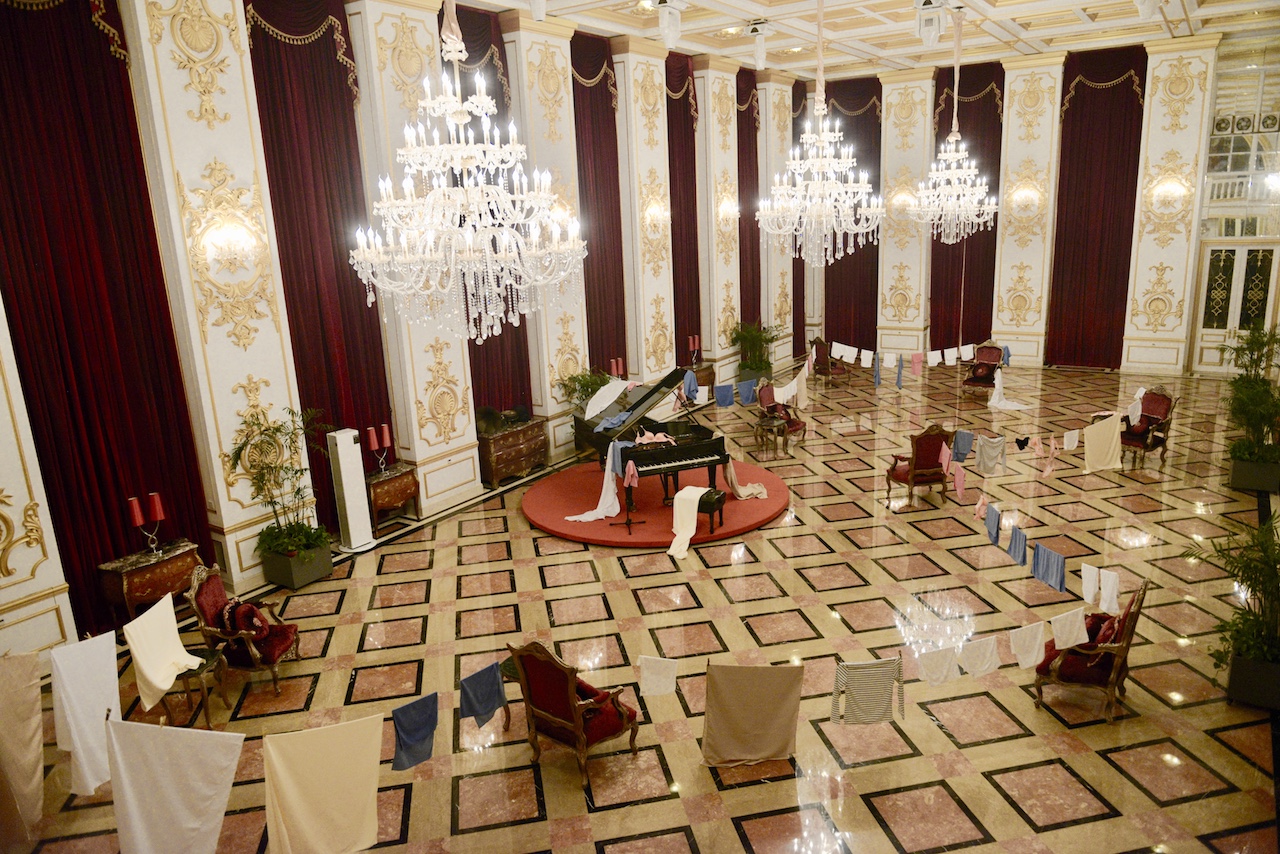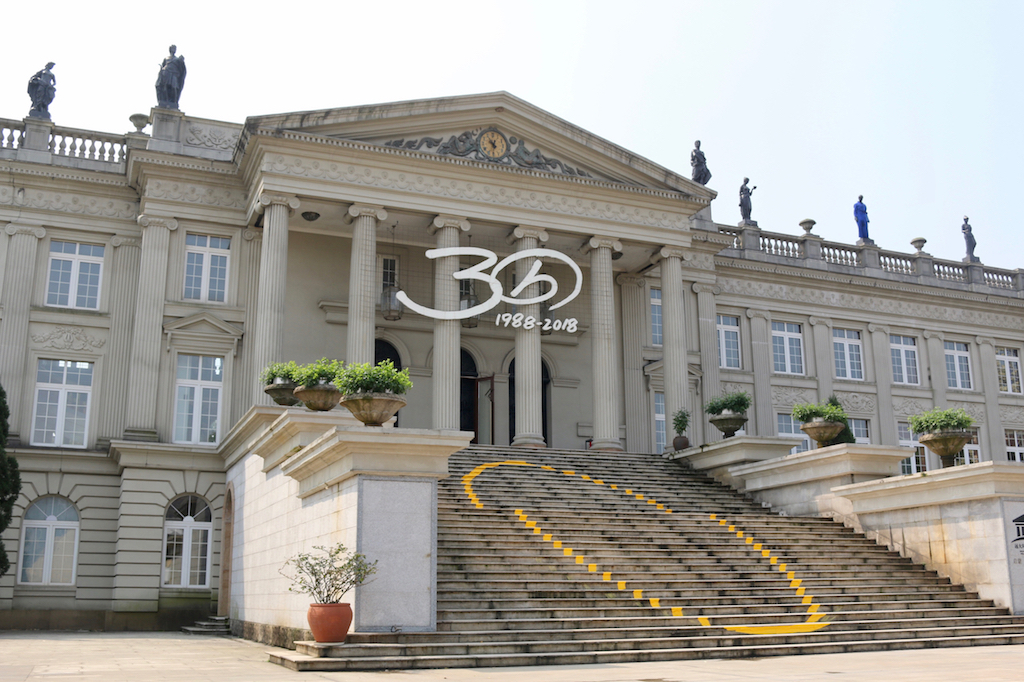We visited the newly opened residency P8 in Changsha this month, which focusses on new media art and issues around sustainability. Tianyou Huang was one of the artists-in-residence earlier this year, who made the "Golden Circle" installation the stairs of the main building. We talked with him about his time at the residency, working on factory grounds, and on his impressions of Changsha in general.
CR: Hi Tianyou! Great to talk to you digitally. To start with, can you tell us a bit about your background?
TY: I’m an artist based in China and London. I make kinetic art, sculptures, performance art to explore the expression of absurdity through combining different signs. My work has always been about daily objects and I’m definitely a tree lover.
CR: You have completed a Bachelor in Sculpture at the Academy of Fine Arts in Guangzhou and just finished your Master in Sculpture at the Royal College of Art in London, was this your first time back in China after graduation?
TY: Yes.
CR: How did you hear about the residency?
TY: I wanted to continue my art practice when I came back to China, so I was looking for the chance of an artist residency by searching the internet, then I found it.
CR: What made you apply to the residency?
TY: I thought it is very important to gain enough practical experience if I want to be a good artist. Also, P8 focuses on the relationship between nature and industry, which is quite interesting to me.
CR: How long did you stay at P8?
TY: I stayed there for two months.
CR: Did you apply with a specific project idea in mind, or were you looking for inspiration on the spot?
TY: I prepared several ideas before coming to P8, but after I looked for ideas based on the specific environment and culture, I just put my previous ideas aside. However, I still thought about how to develop my previous ideas based on the context, and how to combine my practical methodology with the environment. For me, it is impossible to discuss one thing alone, out of the context.
CR: What was the impression when you first arrived at P8?
TY: Cool place, enormous machines, crazy speed of construction, nice people, good food (just a little bit spicy......)
CR: Haha yes, Hunan cuisine can be very spicy. Did you know about the Broad Group's connection to the program when you applied?
TY: Yes I did, but the acquaintance was very narrow.
CR: How did it feel to be an artist in residence on a factory campus turned wetland-creative district?
TY: It’s brilliant, everything could be art, and this transformation shows that how significant creation is. I felt this combination inspired me a lot.
CR: You did a performance project in the main building of the company on which P8 is situated, which included displaying the workers’ undergarments in its main hall. How was this project received by the workers, visitors or from people from the company themselves?
TY: It is a very critical piece, and I didn’t think some people would accept it. From the perspective of workers, they were confused and they didn’t really understand why I wanted to collect their daily objects, and hang them in the hall. Some visitors thought it was ridiculous, as they saw a very sharp contrast. I feel like...... from the first sight, the majority of them think it’s a confusing view, but some people might ask “why”, and think about the idea behind the work.

"Golden Hall". Installation by Tianyou Huang, 2019.
CR: You also created a circle on the front steps of the hall, meant to be seen from a distance. How did this work come about? Can you tell us a bit more about working with the scale of the sites on hand?
TY: Circle is philosophy. There is a Chinese saying, which is: 有些事情走着走着,做着做着就圆了. It means: sometimes you just need to be natural and keep walking, then your things would be completed like a circle. Accordingly, the circle changes when a visitor walks to different positions, and during the walking process, he/she would find the best position to see the standard circle. I think this process of seeking is very similar to the meaning of life.
By the way, honestly, it was very difficult to make this work alone, just by hand. In the process, I need to walk back hundreds of times to check the shape of the unfinished circle.


"The Circle". Installation by Tianyou Huang, 2019.
CR: There are also two statues on the roof wearing the Broad Group worker uniform [as seen on the second statue from the right in a blue uniform]. Was that also one of your interventions?
TY: I don’t think so, but why cannot it be? If you say it is, then it is.
CR: What other projects did you work on during your time at P8?
TY: I have made other 5 works besides the two I mentioned before. The first one is a kinetic artwork which is made of a picture of my mother and a brush. The second one is an installation which is combined with a flag and an electric fan. The third one is kinetic art as well: a plant that can shake. The fourth one is a combination between the first Chinese private plane [belonging to the company CEO and parked inside the pyramid on the factory campus] and the underwear, and the last one is a video work.
CR: Did you feel like your needs were taken care of during the residency? Did you have the support you needed to create the work you set out to make?
TY: I think this residency is well-organized, I had the support that I wanted.
CR: Did your work or practice change significantly from this residency?
TY: No, still the same, but from another perspective, they have been changed more or less.
CR: Who did you interact with the most on the residency team? Did you get the chance to meet the CEO of the company?
TY: I interacted with the other three artists frequently. I had many chances to meet the CEO, basically we had meeting once or twice a week.
CR: To which extent did this residency differ from your previous working spaces?
TY: This is an industrial area, so I really wanted to do something relates to it. During the process, I was inspired by the workers, the factories, and the buildings. They are the things that I hadn’t experienced in other working places before.
CR: What opportunities did you have to share your work with the public? Any exhibitions, concerts or workshops?
TY: On 10th April, we had an open-studio show in the industrial park, that was a “Work in Progress” show. During the middle of June, we will have the final show in the P8 pyramid.
CR: Did you spend much time in the city of Changsha?
TY: Yes, I spent 90% time in Changsha during the residency.
CR: The residency is on the outskirts of the city, did you explore the area around P8 at all? If so, what is the neighboring area like?
TY: In my spare time, I often went to the nearest market. There are many stores, things are cheap. 90% of people there are from outside of Changsha, I feel that these migrant workers create the special characteristic of the city and form a complicated social system together with the native residents.
CR: Were there other artists at P8 while you were there? Did collaborations occur?
TY: Yes, there were three other artists except me. They are lovely people, but we worked independently.
CR: Are there any outcomes or insights which you would not have expected?
TY: I don’t really expect things. Everything went naturally there.
CR: What are you working on next?
TY: I will go to England to do my fine art PhD degree in September this year.
